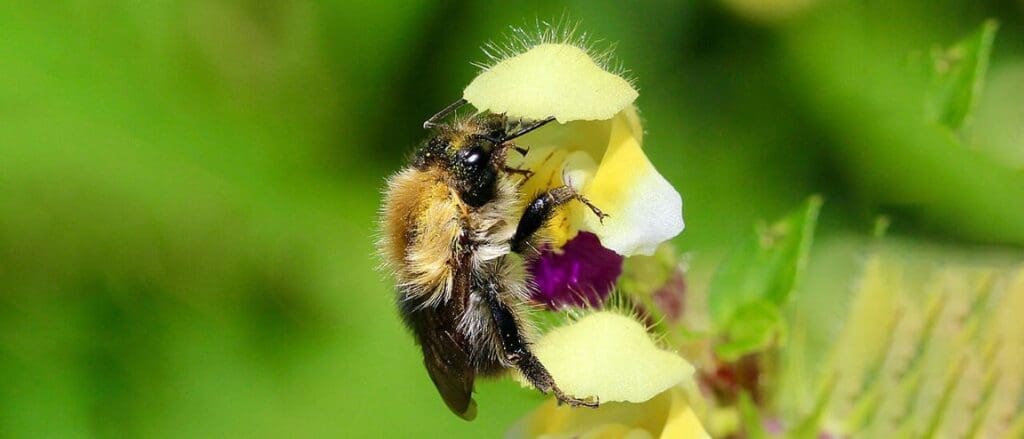Explore the latest insights from top science journals in the Muser Press daily roundup (August 26, 2025), featuring impactful research on climate change challenges.
In brief:
Industry managed forests more likely to fuel megafires
The odds of high-severity wildfire were nearly one-and-a-half times higher on industrial private land than on publicly owned forests, a new study found. Forests managed by timber companies were more likely to exhibit the conditions that megafires love – dense stands of regularly spaced trees with continuous vegetation connecting the understory to the canopy.
The research, led by the University of Utah, University of California, Berkeley, and the United States Forest Service, is the first to identify how extreme weather conditions and forest management practices jointly impact fire severity.Leveraging a unique lidar dataset, the authors created three-dimensional maps of public and private forests before five wildfires burned 1.1 million acres in the northern Sierra Nevada, California.
In periods of extreme weather, stem density – the number of trees per acre – became the most important predictor of a high-severity fire. Even in the face of accelerating climate change, how we manage the land will make a difference.
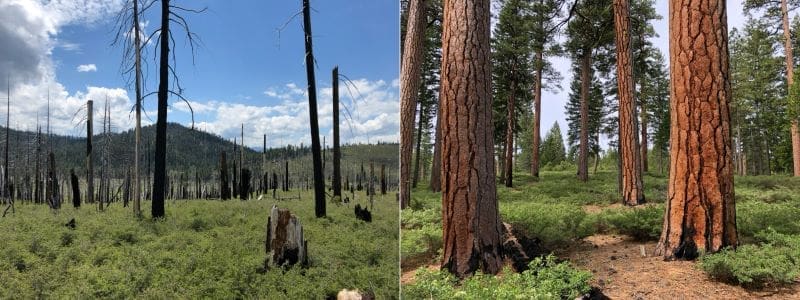
“That’s a really hopeful finding because it means that we can adjust how we manage these landscapes to impact the way fires move through them,” said Jacob Levine, postdoctoral researcher at the U and lead author of the study. “Strategies that reduce density by thinning out both small and mature trees will make forests more robust and resilient to fire in the future.”
In a 2022 study, Levine and collaborators found that fire severity was typically higher on privately managed forests. They also discovered the risks extended to areas near to, but not owned by, private industry, threatening the wilderness, small landowners and urban areas in their shadow. This new study is the first to identify the underlying forest structures that make high-severity fires more likely in some areas than in others.
The study was published in the journal Global Change Biology.
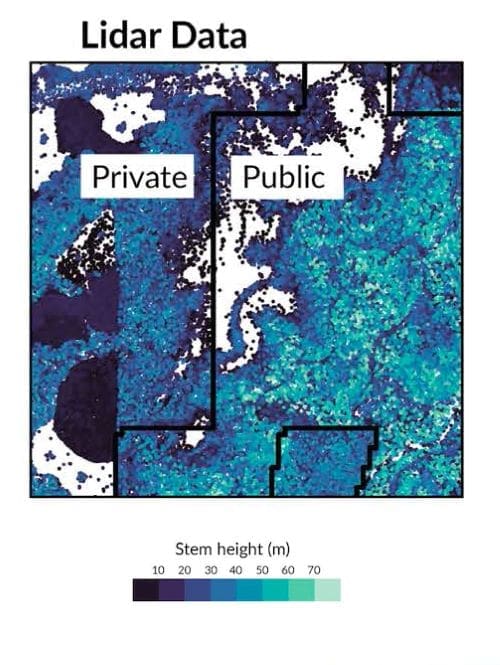
Lidar unlocks forest structure secrets
Plumas National Forest, the study area in California’s northern Sierra Nevada, is emblematic of the wider trend of wildfire occurrence and severity. The region’s mixed conifer forests are adapted to periodic, low- to medium-severity fires that cleared vegetation, creating large spaces between clumps of trees.
Efforts to increase timber resources led the U.S. government to implement fire suppression policies in the 1800s, including a ban on controlled burns that Indigenous People practiced for millennia. In the absence of natural fire cycles and Indigenous burning, modern forests have more fodder to fuel high-severity fires, defined as a fire that kills more than 95% of overstory trees.
Plumas National Forest is a mosaic of private industrial and public ownership, and 70% of the study area was burned in five massive wildfires between 2019 and 2021, including the largest single fire in California’s recorded history, the Dixie Fire. Serendipitously, a unique dataset had been collected a year before the region burned.
In 2018, the U.S. Forest Service, Geological Survey and National Aeronautics and Space Administration surveyed the Plumas National Forest and surrounding private land using airborne light detection and ranging (lidar) flights. The lidar sensors shoot billions of lasers at the landscape below, which bounce off the grass, shrubs, saplings, tree canopies and other structures in the forest with high precision.
“We have a really detailed picture of what the forest looked like immediately before these massive fires. It’s an unbelievably valuable thing to have,” Levine said. “Understanding the forest structures that lead to high-severity fire allows us to target mitigation strategies to get ahead of this massive fire problem while still producing enough timber to meet market demand.”
Private vs public management strategies
Timber companies are focused on maximizing profits and providing a sustainable source of wood, a valuable resource for society and economic engine for rural communities. Most practice plantation forestry – clear-cutting an area and replanting the trees in a tightly packed grid. After 80 to 100 years, they do it all again, leaving a patchwork of dense stands of trees of similar age and size.
“You can think about stacking a bunch of matches together in a grid – that’s going to burn a lot better than if you have those matches dispersed as smaller clumps,” Levine explained. “A bigger fire can easily reach the canopy in dense forests. Then it’s ripping through one tree after another, tossing out chunks of burning material miles in advance. It’s a different story.”
The objectives of public lands are more varied, requiring management for grazing, recreation, restoration, timber production and wildlife corridors. They’re also beholden to the public, which stymies their ability to do active management. Environmental organizations often sue to stop proposed projects that would remove trees to thin down density.
Although the study demonstrates that private industrial lands fare worse, both private and public agencies have much room for improvement to protect our nation’s forests. Most Sierra Nevada trees lack adaptations to recover from high-severity fires, leading to more and more of our forests turning into shrub and grasslands.
“This has major implications for timber, but also for carbon sequestration, water quality, wildlife habitat and recreation,” Levine said. “Shrub and grasslands can be beautiful, but when we think of the Sierra Nevada we picture majestic forests. Without major changes in forest management, future generations could inherit a landscape that looks very different than the one we cherish today.”
Journal Reference:
Levine, J. I., B. M. Collins, M. Coppoletta, and S. L. Stephens, ‘Extreme Weather Magnifies the Effects of Forest Structure on Wildfire, Driving Increased Severity in Industrial Forests’, Global Change Biology 31, 8: e70400 (2025). DOI: 10.1111/gcb.70400
Article Source:
Press Release/Material by Lisa Potter | University of Utah
Ash dieback is triple whammy for net zero plans
Ash dieback and other tree diseases are resulting in significantly more greenhouse gas emissions than previously thought because a large amount of carbon is escaping from woodland soils, a study has found. This is in addition to carbon losses from tens of millions of dying trees and reduced removal of CO₂ from the atmosphere due to the widespread deaths of mature ash trees.
The research team led by the UK Centre for Ecology & Hydrology (UKCEH) says that the exponential rise in tree diseases across the world are likely to hamper forests’ ability to help meet net zero plans.
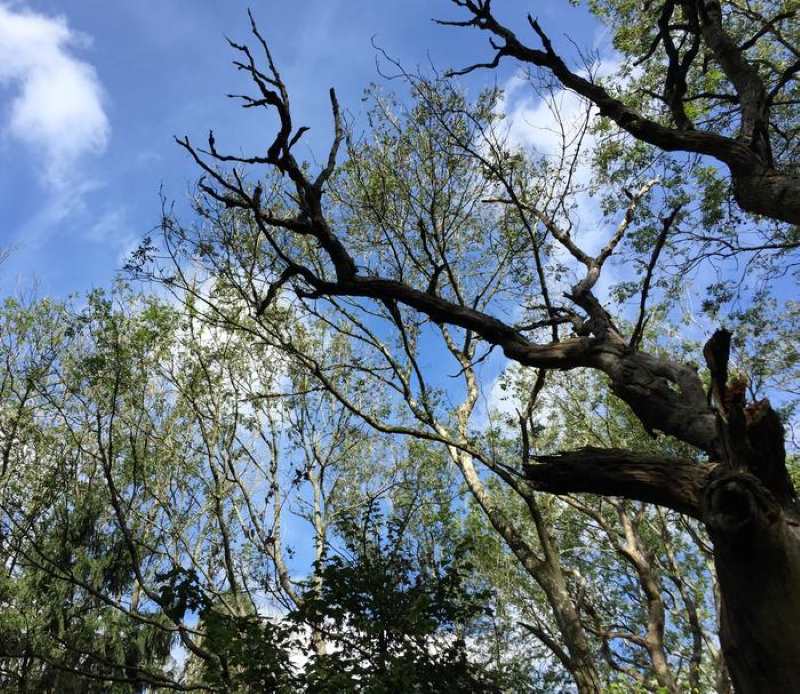
They estimate losses from soils alone due to ash dieback in British woodlands resulted in 5.8 million tonnes of CO₂ emissions over five years (2016-21). This is equivalent to over half the amount of CO₂ removed from the atmosphere by broadleaf woodlands in Great Britain in a year, or alternatively the total amount of CO₂ emitted by cars travelling on Scotland’s roads annually.
While the loss of carbon from diseased trees themselves and reduced removal of CO₂ has been previously noted by scientists, the authors of the latest study say a third impact – the effects on carbon cycling and storage in the surrounding environment – have not been considered before.
“Tree disease is a triple whammy for climate change mitigation,” said UKCEH ecologist Dr Fiona Seaton, who led the study, published in Global Change Biology. “A lot of future net zero plans assume a certain level of forest carbon sequestration but this is threatened by the exponential increase in tree diseases such as ash dieback in Britain and across the world.”
Widespread deaths of trees
An estimated nine million trees have so far died in British woodlands as a result of ash dieback, with up to 100 million others expected to be lost over the next 30 years. The disease is therefore going to continue to have significant impacts on woodlands’ ability to store and remove the greenhouse gas and mitigate climate change.
Organic carbon underpins the entire soil food web, so any loss will have negative impacts upon ecosystem services. But the study authors, from UKCEH as well as Lancaster University, the Woodland Trust and University of Oxford, say there is still limited knowledge about the impact of tree diseases on carbon cycling, especially below ground.
They say the difference in the amount of greenhouse gas released and absorbed across woodlands in response to tree disease needs to be better understood.
Jeopardising wildlife
Chris Nichols of the Woodland Trust, a coauthor of the study, said: “Ash are among the most common trees in the UK, and the imported dieback fungus is one of the biggest threats facing British woodlands. Not only does it jeopardise the wildlife that depend on ash, and risk costing the UK billions of pounds in the future, but we are increasingly understanding what dieback could mean for climate change resilience. This kind of research is vital in refining our approach to woodland conservation.”
The research was carried out as part of an extensive survey of the physical and chemical composition of Britain’s broadleaf woodlands. The Bunce Survey, led by UKCEH, was carried out at multiple plots on around 100 sites across Britain in 1972, 2001 and most recently in 2022. This unique study shows how our woodlands have changed over the past 50 years due to climate change and land management.
The researchers measured the amount of soil carbon in topsoil in the surveyed woodlands, and compared how soil carbon levels changed in plots with and without ash dieback over the three surveys.
The research was funded by the Woodland Trust and the EU Horizon programme.
Journal Reference:
Seaton, F. M., D. A. Robinson, C. M. Wood, et al., ‘Forest Topsoil Organic Carbon Declines Under Ash Dieback’, Global Change Biology 31, 8: e70430 (2025). DOI: 10.1111/gcb.70430
Article Source:
Press Release/Material by UK Centre for Ecology & Hydrology (UKCEH)
‘Cyborg jellyfish’ could aid in deep-sea research, inspire next-gen underwater vehicles
In a towering aquarium in a darkened laboratory, moon jellyfish (Aurelia aurita) hover as if floating in space.
The glow of neon lights illuminates their translucent, bell-shaped bodies as they expand and contract rhythmically, their graceful tentacles flowing in wavelike patterns.

CU Boulder engineer Nicole Xu watches them with fondness. Xu, an assistant professor in the Paul M. Rady Department of Mechanical Engineering, first became fascinated with moon jellies more than a decade ago because of their extraordinary swimming abilities. Today, Xu has developed a way to harness their efficiency and ease at moving through the water in ways that could make some types of aquatic research much easier.
She fits the jellies with microelectronic devices that activate key swimming muscles, enabling researchers to steer them toward remote ocean areas that are hard to access in any other way. Eventually, she plans to add sensors to the devices that can gather critical data on temperature, pH and other environmental characteristics.
“Think of our device like a pacemaker on the heart,” Xu said. “We’re stimulating the swim muscle by causing contractions and turning the animals toward a certain direction.”
The study is published in the journal Physical Review Fluids.
Going where humans can’t go
As climate change accelerates, ocean waters are becoming less hospitable for a variety of marine life. The ocean is getting warmer and more acidic as it absorbs growing amounts of atmospheric carbon dioxide.

Measuring changes in the ocean is essential to understanding how human activities are impacting all life on Earth. But because the ocean is so vast and deep, some parts are hard to study without prohibitively expensive equipment. The cyborg jellies could offer a way for humans to wade into these relatively uncharted waters.
Moon jellyfish are the most energy-efficient animals on the planet. They’re prehistoric, with a simple body structure that has stayed the same for more than 500 million years. As invertebrates, they also lack a brain or spinal cord, though they do have basic organs and a pair of overlapping nerve nets. Importantly, the jellies do not have nociceptors, or sensory receptors that can detect potentially harmful stimuli.
Moon jellies can range from a centimeter to more than a foot in diameter. Their short, fine tentacles help them sting and catch prey like zooplankton, crustacean larvae and small fish. But thankfully for Xu, their sting cells can’t penetrate human skin.
Though they’re often found near coastlines, close to their favorite food sources, moon jellies live in diverse habitats worldwide and can swim to incredible depths: They’ve been found in some of the lowest places on Earth, including the Mariana Trench, which sits roughly 36,000 feet beneath the western Pacific Ocean’s surface at its deepest point.
Xu co-created the biohybrid robotic jellyfish concept with her former academic advisor about five years ago, and she first tested them in the field in 2020, steering them around shallow ocean waters off the coast of Woods Hole, Mass.
On top of the implications for ocean and climate research, Xu believes we can draw inspiration from the jellyfish.
“There’s really something special about the way moon jellies swim. We want to unlock that to create more energy-efficient, next-generation underwater vehicles,” she said.
Striving for ethical research
Today, Xu spends much of her time studying precisely how moon jellies move through the water with such ease.
Xu, research associate Yunxing Su and graduate student Mija Jovchevska published a new study late last month that involved adding biodegradable particles to a jellyfish tank. The researchers then shone a laser through the tank to illuminate the suspended particles in the water and visualize how water flows when jellies swim.

In the past, researchers have used synthetic tracers such as silver-coated glass beads to look at underwater flow patterns, but the new study suggests biodegradable particles, such as corn starch, could be more sustainable, more affordable and less toxic alternatives.
She and graduate student Charlie Fraga are also working on making the jellyfish easier to steer in the wild. Going forward, Xu hopes to design other nature-inspired tools for studying the ocean.
There’s more to learn about the ethics of studying invertebrates. In a paper published earlier this year, Xu and others pointed out the need for more investigation of how research affects invertebrates. It was once widely believed that invertebrates couldn’t feel pain, but there is growing evidence that some do react to aversive stimuli.
Through all of her research, Xu says she strives to minimize harm to the animals she works with. When they’re stressed, moon jellies may secrete extra mucus, and they often stop reproducing. But Xu’s jellies have not shown increased mucus production, and small polyps – baby jellyfish the size of a pinhead whose tentacles are just beginning to form – line the inside of Xu’s jellyfish tanks.
“It’s our responsibility as researchers to think about these ethical considerations up front,” Xu said. “But as far as we can tell, the jellyfish are doing well. They’re thriving.”
Journal Reference:
Yunxing Su, Mija Jovchevska and Nicole W. Xu, ‘Biodegradable tracer particles for underwater particle image velocimetry’, Physical Review Fluids 10, 074905 (2025). DOI: 10.1103/bg66-976x
Article Source:
Press Release/Material by Amber Carlson | University of Colorado at Boulder (CU Boulder)
Gene sequencing uncovers differences in wild and domesticated crops
With climate change and more frequent extreme weather events, researchers predict that global yields of important crops like maize, rice, and soybeans could decline by 12 to 20% by the end of the century. To prepare, plant scientists are hoping to find ways to improve yields and grow hardier varieties of these crops. New insights into the genetic makeup of wild varieties of common crops show how domestication has changed crop traits over time and propose a new cultivation method to improve genetic diversity.
The research was shared in a paper published in Life.
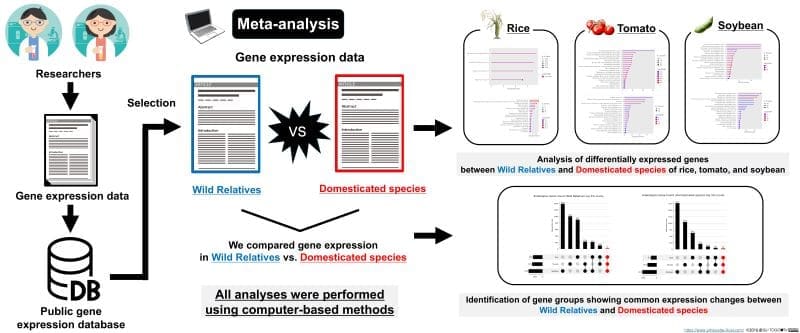
“While domesticated species have originally been bred by cultivating wild species, the resulting reduction in genetic diversity can damage all individuals by exposing them to diseases and environmental stresses. To solve this problem, we set out to identify differences in crop traits between wild relatives and domesticated species and to contribute to the selection of new breeding candidate genes. The introduction of useful traits, especially those found in wild relatives, may provide hints for the development of new useful varieties,” said Hidemasa Bono, a professor at Hiroshima University’s Graduate School of Integrated Sciences for Life in Hiroshima, Japan.
The researchers used RNA sequencing data from public databases, including the National Center for Biotechnology Information Gene Expression Omnibus and published studies online. They focused on crops with wild relatives that had widely available RNA sequencing data: tomatoes, rice, and soybeans. The gene expression data of the wild varieties was then compared to the domesticated varieties. To evaluate the data, researchers classified all genes into three groups: upregulated, unchanged, and downregulated.
By understanding the gene expression comparison between the wild varieties and the domesticated varieties, researchers could understand differences in how the plants respond to stressors. “Wild relatives have high environmental stress tolerance with the potential to respond to climate change and severe changes in the natural environment, which has been an issue in recent years,” said Bono.
The researchers found 18 genes that were upregulated in the wild relatives and 36 genes that were upregulated in the domesticated species. Wild species were found to have genes related to environmental stress responses while domesticated species had more genes related to the hormone regulation and chemical compound export and detoxification. For example, a gene called HKT1 affects salt stress response and salt tolerance was found to be upregulated in wild varieties.
This could be an opportunity to develop crops that can grow in soil with more saline. Researchers also found genes that were upregulated in wild varieties that helped with drought stress (RD22), water stress (HB-12), leaf development and photosynthesis promotion (HB-7), and osmotic stress response and wound signaling (MYB102).
In domesticated plants, researchers also found beneficial genes that were upregulated compared to wild varieties. Several genes help detox the plants and remove chemicals found in soil. One gene (ALF5) improves the plant’s resistance to tetramethylammonium, and another (DTX1) manages cadmium and toxic compounds. These genes and others can help plants grow in soils that have been contaminated by chemicals. Researchers suspect this may have become beneficial for plants because of increased pesticide and chemical fertilizer use.
“The three wild species used in this analysis – rice, tomato, and soybean – had in common high expression levels of genes that contribute to stress responses, such as drought, osmotic pressure, and wound stress. The high expression levels of genes that contribute to stress tolerance that these three less closely related species have in common suggest that wild species of other species are likely to have useful traits as well,” said Bono.
Looking ahead, researchers hope to learn even more about these essential differences between wild relatives and domesticated species to improve breeding. “In addition, we would like to collect and reanalyze data used in crop breeding research to construct a database that will contribute to the promotion of digital breeding of crops,” said Bono.
Journal Reference:
Yumiya, M., & Bono, H., ‘Meta-Analysis of Wild Relatives and Domesticated Species of Rice, Tomato, and Soybean Using Publicly Available Transcriptome Data’, Life 15, 7: 1088 (2025). DOI: 10.3390/life15071088
Article Source:
Press Release/Material by Hiroshima University
Featured image credit: Gerd Altmann | Pixabay




